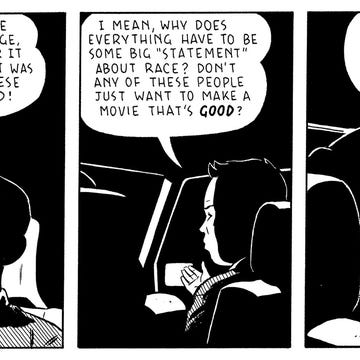Earlier this year, state senator Dave Cortese introduced a bill to offer California farmworkers expedient medical attention and compensation for illnesses induced by the heat, in an effort to encourage industry adherence to labor-safety conditions. There have been alarming reports of California agricultural laborers working in extreme conditions, feeling faint and dizzy, only to continue to work without respite or medical care. Helena María Viramontes, in her 1995 debut novel, Under the Feet of Jesus, maps the terrain of such circumstances primarily through the multivaried perspective of Estrella, a young Mexican American girl from a migrant farmworker family, as she comes of age.
Under the Feet of Jesus is lyrical and polyphonic. It features a range of brief perspectives that chart the scenes of Estrella’s family as they work in the Central Valley. Her mother, her twin sisters, her two older brothers, and a looming fatherlike figure, Perfecto, attempt to forge a life for themselves under intense conditions: the blazing heat of the sun, the physical intensity of food-gathering, the uncertainty of finding work, the psychic toll of financial precarity, and the emotional abyss of feeling like a perpetual outsider. “Don’t let them make you feel you did a crime for picking the vegetables they’ll be eating for dinner. If they stop you…you tell them the birth certificates are under the feet of Jesus, just tell them,” Estrella’s mother, Petra, instructs her. The title of the novel refers to the place where Petra keeps her family’s documentation and valuable possessions; it also carries a biblical resonance that implicates the story’s rumination on faith, which lifts the novel to a textured terrain. Here, we begin to think about duty, sacrifice, and humility.
In the midst of Estrella’s daily labor, she encounters Alejo, who is immediately magnetized by her. The narrator tells us, “What he saw was the woman who swam in the magnetic presence of the full moon, a woman named Star.” And Estrella holds him in warm regard. He, too, is a young migrant farmworker seeking employment and stability. Estrella slowly arrives at a sense of womanhood despite a communal anxiety and mythos (one suffused with a lack of bodily autonomy and the imminence of sexual violence) pulsing around her. When she stays out too late instead of being at home, her mother scolds her, saying, “Estrella should have been safely tucked away like the other women of the camp because the moon and earth and sun’s alignment was a powerful thing. Unborn children lurking in their bodies were in danger of having their lips bitten just like the hare on the moon if nothing was done to protect them.”
Under the Feet of Jesus builds its rich and sensorial milieu through the accretion of certain community myths and notions of being, as well as a deep-rooted attention to the environment that the characters of the novel inhabit and the objects that surround them. Arguably, each character is able to understand their life and physical body only through their relationship with the earth. When pesticide spraying sweeps through the farm and nearly takes Alejo’s life, the novel moves toward a climax and denouement that compel us to reflect on the meaning of faith and resilience in the face of such hardship, which isn’t to romanticize suffering but to acknowledge the ways in which individuals, through the strength of their community and the promise of the collective, can rise above seemingly insurmountable challenges.
While Under the Feet of Jesus was published in 1995, many of its core conflicts persist today. The setting of the farm—which is, at once, anchored by the beauty of its environs but made claustrophobic by the precarity and need of labor—becomes a larger frame to think about labor policies, environmental justice, capitalism, food production, migration, and racism. Still, at its heart, Viramontes’s debut novel is rooted in the story of a community and how acts of faith can lead one’s imagination to leap toward visions of a better life and world.•
Join us on August 15 at 5 p.m. Pacific time, when Viramontes will sit down with CBC host John Freeman and special guest Manuel Muñoz to discuss Under the Feet of Jesus. Register for the Zoom conversation here.
CALIFORNIA STRUGGLES
Alta Journal assistant editor Elizabeth Casillas writes about the hardships faced by female migrant farmworkers. —Alta
SHAPING THE NARRATIVE
Read author Manuel Muñoz’s (The Consequences) thoughtful essay on the Central Valley. —Alta
THE COST OF EMPOWERMENT
Zan Romanoff reviews Rufi Thorpe’s Margo’s Got Money Troubles. —Alta
AUGUST RELEASES
Here are 10 new releases by writers on and of the West that we’re excited about. —Alta
MOUNTAIN JOURNALISM
Read Alta senior editor Matt Haber’s piece on Mike Rogge, the Lake Tahoe publisher of the Mountain Gazette. —Alta
HOMEWARD BOUND
Read an excerpt of Grace Loh Prasad’s San Francisco memoir, The Translator’s Daughter. —Rumpus
Alta’s California Book Club email newsletter is published weekly. Sign up for free and you also will receive four custom-designed bookplates.



















